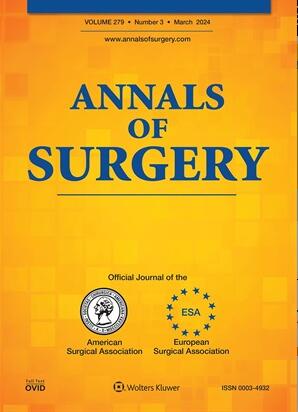Divorce Among Surgeons and Other Physicians in the United States.
IF 6.4
1区 医学
Q1 SURGERY
引用次数: 0
Abstract
OBJECTIVE To compare divorce prevalence among surgeons with that of non-surgeon physicians. SUMMARY BACKGROUND DATA The demanding nature of a career in surgery uniquely challenges the social wellbeing of a surgeon; however, its impact on marital health has not yet been well described. METHODS A cross-sectional study was conducted using publicly available U.S. Census data from 2017-2021 to investigate prevalence of divorce across different occupations. Survey respondents were divided into two groups, surgeons and non-surgeon physicians, with the remaining Census participants as a control. All participants under the age of 18 were excluded to focus on the U.S. adult population. Lifetime prevalence of divorce was measured across occupations and multivariable logistic regression analyses were performed to identify factors independently associated with divorce. Secondarily, the occurrence of more than one marriage was used to supplement understanding of marital health. RESULTS A total of 3,171 surgeons and 51,660 non-surgeon physicians were identified, with both groups similarly aged (51.6 and 50.2 y, respectively) and predominately male (82.9% and 61.9%, respectively). In unadjusted analysis, 21.3% (676/3,171) of surgeons had undergone a divorce compared to only 17.9% (9,252/51,660) of non-surgeon physicians, a 19% increase in risk of divorce (Risk ratio [RR]=1.19; 95% confidence interval [95% CI], 1.11-1.28). Both surgeons and non-surgeon physicians were significantly less likely to report being divorced compared with the general population. The increased divorce prevalence among surgeons persisted in multivariable analysis that adjusted for age, age at time of marriage, sex, race, income, hours worked per week, and number of children in the household, with surgeons experiencing a 22% increased prevalence of divorce over non-surgical physicians (adjusted divorce prevalence of 21.8% vs. 18.7%, respectively; odds ratio [OR]=1.22; 95% CI, 1.09-1.35). In subgroup analysis, the finding of higher divorce prevalence for surgeons over non-surgeon physicians was concentrated among men (adjusted divorce prevalence: 22.6% of male surgeons vs. 18.9% of male non-surgeon physicians; adjusted OR 1.26, 95% CI, 1.11-1.42), White (adjusted divorce prevalence: 22.4% of white surgeons vs. 19.1% of white non-surgeons; adjusted OR 1.22, 95% CI, 1.09-1.38) and Asian surgeons (adjusted divorce prevalence: 12.0% of Asian surgeons vs. 8.1% of Asian non-surgeons; adjusted OR 1.55, 95% CI, 1.06-2.26), with the effect not present in other measured subgroups. CONCLUSIONS Both surgeons and physicians have lower divorce prevalence than the general population. Surgeons exhibit higher prevalence of divorce compared with non-surgeon physicians, with measured demographic and work characteristics insufficient to explain this difference.美国外科医生和其他医生的离婚情况。
目的比较外科医生与非外科医生的离婚率。摘要背景资料外科职业的苛刻性质对外科医生的社会福利提出了独特的挑战;然而,其对婚姻健康的影响尚未得到很好的描述。方法利用公开的 2017-2021 年美国人口普查数据开展了一项横断面研究,以调查不同职业的离婚率。调查对象分为两组,即外科医生和非外科医生,其余人口普查参与者作为对照组。所有 18 岁以下的参与者均被排除在外,以关注美国成年人口。对不同职业的终生离婚率进行了测量,并进行了多变量逻辑回归分析,以确定与离婚独立相关的因素。结果共发现 3,171 名外科医生和 51,660 名非外科医生,两组年龄相仿(分别为 51.6 岁和 50.2 岁),男性占多数(分别为 82.9% 和 61.9%)。在未经调整的分析中,21.3%(676/3171)的外科医生经历过离婚,而非外科医生中只有 17.9%(9252/51660)经历过离婚,离婚风险增加了 19%(风险比 [RR]=1.19; 95% 置信区间 [95% CI],1.11-1.28)。与普通人群相比,外科医生和非外科医生报告离婚的可能性都明显较低。在对年龄、结婚年龄、性别、种族、收入、每周工作时间和家庭中子女数量进行调整后的多变量分析中,外科医生的离婚率持续上升,与非外科医生相比,外科医生的离婚率增加了 22%(调整后的离婚率分别为 21.8% 和 18.7%;赔率比 [OR]=1.22; 95% CI, 1.09-1.35)。在亚组分析中,发现外科医生的离婚率高于非外科医生,这主要集中在男性中(调整后的离婚率:外科医生男性为 22.6%,非外科医生男性为 18.9%;调整后的 OR 为 1.26,95% CI 为 1.35)。26,95% CI,1.11-1.42)、白人(调整后的离婚率:白人外科医生为 22.4%,白人非外科医生为 19.1%;调整后的 OR 为 1.22,95% CI,1.09-1.38)和亚裔外科医生(调整后的离婚率:亚裔外科医生为 12.0%,亚裔非外科医生为 19.1%;调整后的 OR 为 1.22,95% CI,1.09-1.38):结论外科医生和内科医生的离婚率均低于普通人群。与非外科医生相比,外科医生的离婚率更高,而人口统计学和工作特征不足以解释这种差异。
本文章由计算机程序翻译,如有差异,请以英文原文为准。
求助全文
约1分钟内获得全文
求助全文
来源期刊

Annals of surgery
医学-外科
CiteScore
14.40
自引率
4.40%
发文量
687
审稿时长
4 months
期刊介绍:
The Annals of Surgery is a renowned surgery journal, recognized globally for its extensive scholarly references. It serves as a valuable resource for the international medical community by disseminating knowledge regarding important developments in surgical science and practice. Surgeons regularly turn to the Annals of Surgery to stay updated on innovative practices and techniques. The journal also offers special editorial features such as "Advances in Surgical Technique," offering timely coverage of ongoing clinical issues. Additionally, the journal publishes monthly review articles that address the latest concerns in surgical practice.
 求助内容:
求助内容: 应助结果提醒方式:
应助结果提醒方式:


